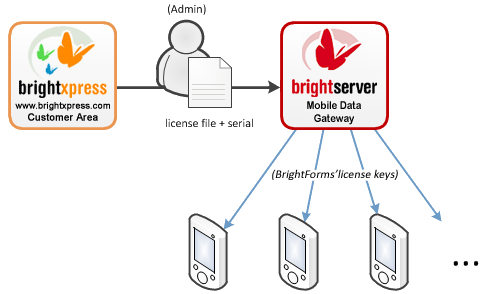Installing BrightServer
Contents Hide
Installing BrightServer
BrightServer may be distributed via Windows Installable exe file, or via zip/tar.gz. Setting up a BrightServer instance in this way will have it run on the default ports (HTTP: 8080, HTTPS: 8443, Remote: 12921) until changed via BrightBuilder.
Please note that if BrightServer cannot bind to any of the default ports on startup, it will not start, logging the errors in the ./log/ directory of installation.
If multiple instances of BrightServer are required on the same server, and the default ports are currently in use, please refer to the Installing Multiple BrightServer Instances topic of this document.
Installed BrightServer instances may be registered and configured to run as a service in Windows, if not already. If BrightServer is installed as a service, it will be started automatically after installation. For information how to install, modify and/or uninstall this service after BrightServer installation, please refer to Installing BrightServer as a Windows Service for more information.
Finally, running BrightServer instances must be licensed for connected devices to operate outside of demo mode. An overview on licensing BrightServer may be found here.
Windows x86 or x64 Executable
For Windows installation, run the executable installation file BrightServer Setup to start the installation wizard. There are two available installation executables - one which will install the BrightServer Service automatically (with ".ServiceSetup" suffix), and one without.
Typically, the service setup executable is used, with the other reserved for a customised, manual service installation.
Archived Distributable
Unzip the tar.gz or zip file containing BrightServer
Copy Java Runtime Executable files into the directory where BrightServer was extracted. Rename the directory 'jre_x.x.x' where 'x.x.x' is the version number - eg. jre_1.7.0
Change the permissions of the run.bat or run.sh scripts if necessary, making them executable.
Run the run.bat or run.sh files if in Windows or Linux respectively, or install as a service on Windows.
BrightServer Licenses
Once installed, BrightServer will not have any licenses, and thus operate in Demo Mode. This will limit the number of users allowed to connect to the server to a single device or user for web.
Licensing BrightServer is performed by obtaining the server token and ports for BrightServer and using them to generate licenses via the BrightServer website. This process is detailed in the Licensing BrightServer chapter of this document.
These licenses may be applied to the server by accessing the server's Configuration node under the Servers panel in BrightBuilder. This will supply the server with a set number of licenses, which may then be distributed to license user devices, or web users. Once these run out, any subsequent devices which connect to the server will operate in Demo mode.

For more information this process, please refer to the Appendix > BrightXpress Licensing Model chapter of this documentation.
For steps to license a BrightServer instance, please refer to the How To Deploy Platform Device Licenses tutorial.
